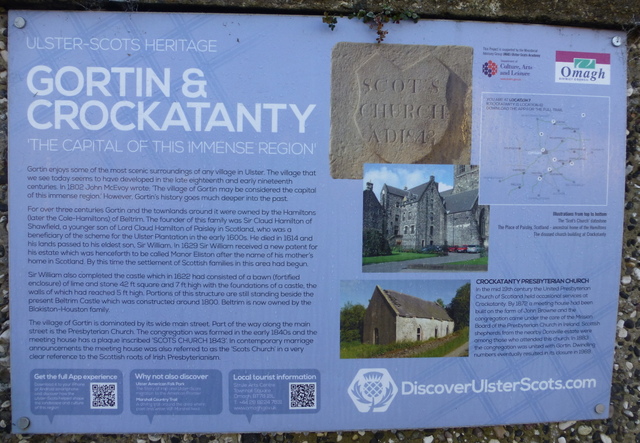Ulster Scots Heritage Information Board, Gortin
Introduction
The photograph on this page of Ulster Scots Heritage Information Board, Gortin by Kenneth Allen as part of the Geograph project.
The Geograph project started in 2005 with the aim of publishing, organising and preserving representative images for every square kilometre of Great Britain, Ireland and the Isle of Man.
There are currently over 7.5m images from over 14,400 individuals and you can help contribute to the project by visiting https://www.geograph.org.uk

Image: © Kenneth Allen Taken: 23 Nov 2016
The following text is included in the description: GORTIN & CROCKINBOY THE CAPITAL OF THIS IMMENSE REGION Gortin enjoys some of the most scenic surroundings of any village in Ulster. The village that we see today seems to have developed in the late eighteenth and early nineteenth centuries. In 1802 John McEvoy wrote: 'The village of Gortin may be considered the capital of this immense region.' However, Gortin's history goes much deeper into the past. For over three centuries Gortin and the townlands around it were owned by the Hamiltons (later the Cole-Hamiltons) of Beltrim. The founder of this family was Sir Claud Hamilton of Shawfield, a younger son of Lord Claud Hamilton of Paisley in Scotland, who was a beneficiary of the scheme for the Ulster Plantation in the early 1600s. He died in 1614 and his lands passed to his eldest son, Sir William. In 1629 Sir William received a new patent for his estate which was henceforth to be called Manor Eliston after the name of his mother's home in Scotland. By this time the settlement of Scottish families in this area had begun. Sir William also completed the castle which in 1622 had consisted of a bawn (fortified enclosure) of lime and stone 42 ft square and 7 ft high with the foundations of a castle, the walls of which had reached 5 ft high. Portions of this structure are still standing beside the present Beltrim Castle which was constructed around 1800. Beltrim is now owned by the Blakiston-Houston family. The village of Gortin is dominated by its wide main street Image] Part of the way along the main street is the Presbyterian Church. The congregation was formed in the early 1840s and the meeting house has a plaque inscribed 'SCOTS CHURCH 1843'. In contemporary marriage announcements the meeting house was also referred to as the 'Scots Church' in a very clear reference to the Scottish roots of Irish Presbyterianism. and on the right: CROCKATANTY PRESBYTERIAN CHURCH In the mid 19th century the United Presbyterian Church of Scotland held occasional services at Crockatanty. By 1872 a meeting house had been built on the farm of John Browne and the congregation came under the care of the Mission Board of the Presbytenan Church in Ireland Scottish shepherds from the nearby Doraville estate were among those who attended this church. In 1883 the congregation was united with Gortin Dwindling numbers eventually resulted in its closure in 1969 Image] Pictured here Image]

